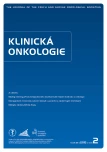Management of Chronic and Acute Pain in Patients with Cancer Diseases
Authors:
M. Sochor 1; O. Sláma 2
Authors‘ workplace:
Komplexní onkologické centrum, Krajská nemocnice Liberec a. s. 2 Ambulance podpůrné a paliativní péče, Klinika komplexní onkologické péče, Masarykův onkologický ústav, Brno
1
Published in:
Klin Onkol 2015; 28(2): 94-98
Category:
Review
doi:
https://doi.org/10.14735/amko201594
Overview
Pain is one of the most important and most frequent symptoms of malignancy. Its intensity and prevalence is growing with disease status. Pain should be present in early stage cancer patients also. Pain is, together with other symptoms (anorexia, nausea, depression, anxiety, sleep disturbances), factor of patients quality ‑ of‑life and proper therapy is responsible for overall patient satisfaction and activity. Right pain management is always multidimensional and pain should be assessed at each contact. In review article we would like to bring some alerts of pain context in complexity of cancer and we would like to stress some forms of acute pain management.
Key words:
chronic pain – acute pain – cancer pain – breakthrough pain – procedural pain – opioids – fentanyl
The authors declare they have no potential conflicts of interest concerning drugs, products, or services used in the study.
The Editorial Board declares that the manuscript met the ICMJE “uniform requirements” for biomedical papers.
Submitted:
25. 2. 2015
Accepted:
10. 3. 2015
Sources
1. Ventafridda V, Tamburini M, Caraceni A et al. A validation study of the WHO method for cancer pain relief. Cancer 1987; 39 : 850 – 856.
2. Deandrea S, Montanari M, Moja L et al. Prevalence of undertreatment in cancer pain. A review of published literature. Ann Oncol 2008; 19(12): 1985 – 1991. doi: 10.1093/ annonc/ mdn419.
3. WHO. Cancer pain relief. 2nd ed. Geneva: World Health Organization 1996.
4. Merskey H, Bugduk N. Classification of chronic pain. Description of Chronic Pain Syndromes and Definitions of Pain Terms. 2nd ed. Seattle, WA: IASP Press 1994.
5. Goudas LC, Bloch R, Gialeli ‑ Goudas M et al. The epidemiology of cancer pain. Cancer Invest 2005; 23(2): 182 – 190.
6. Bennett M, Rayment C, Hjermstad M et al. Prevalence and etiology of neuropathic pain in cancer patients: a systematic review. Pain 2012; 153(2): 359 – 365. doi: 10.1016/ j.pain.2011.10.028.
7. Radbruch L, Trottenberg P, Elsner F et al. A systematic review of the role of alternative application routes for opioid treatment for moderate to severe cancer pain: an EPCRC opioid guidelines project. Palliat Med 2011; 25 : 578 – 596.
8. Caraceni A, Hanks G, Kaasa S et al. Use of opioid analgesics in the treatment of cancer pain: evidence‑based recommendations from the EAPC. Lancet Oncol 2012; 13(2): e58 – e68. doi: 10.1016/ S1470-2045(12)70040 - 2.
9. Davies AM, Dickman A, Reid C et al. Science Committee of the Association for Palliative Medicine of Great Britain and Ireland. The management of cancer‑related breakthrough pain: recommendation of a task group of the Science Committee of the Association for Palliative Medicine of Great Britain and Ireland. Eur J Pain 2009; 13(4): 331 – 338.
10. Haugen DF, Hjermstad MJ, Hagen N et al. European Palliative Care Research Collaborative (EPCRC). Assessment and classification of cancer breakthrough pain: a systematic literature review. Pain 2010; 149(3): 476 – 482. doi: 10.1016/ j.pain.2010.02.035.
11. Svendsen K, Andersen S, Arnason S et al. Breakthrough pain in malignant and non‑malignant diseases: a review of prevalence, characteristics and mechanisms. Eur J Pain 2005; 9(2): 195 – 206.
12. Kabelka L, Kozák J, Lejčko J et al. Doporučený postup pro léčbu průlomové nádorové bolesti. Bolest 2011; 14 (Suppl 1): 1 – 5.
13. Mercadante S, Radbruch L, Davies A et al. A comparison of intranasal fentanyl spray with oral transmucosal fentanyl citrate for the treatment of breakthrough cancer pain: an open ‑ label, randomized, crossover trial. Curr Med Res Opin 2009; 25 : 2805 – 2815.
14. Kress HG, Oronska A, Kaczmarek Z et al. Efficacy and tolerability of intranasal fentanyl spray 50 to 200ug for breakthrough pain in patients with cancer: a phase III, multinational, randomized, double‑blind, placebo ‑ controlled, crossover trial with a 10 ‑ month open ‑ label extension treatment period. Clin Ther 2009; 31 : 1177–1191.
15. Portenoy RK, Tayor D, Messina J et al. A randomized, placebo ‑ controlled study of fentanyl buccal tablet for breakthrough pain in opioid‑treated patients with cancer. Clin J Pain 2006; 22(9): 805 – 811.
16. Slatkin NE, Xie F, Messina J et al. Fentanyl buccal tablet for relief of breakthrough pain in opioid ‑ tolerant patients with cancer related chronic pain. J Support Oncol 2007; 5(7): 327 – 334.
17. Zeppetella G, Ribeiro MD. Opioids for the management of breakthrough (episodic) pain in cancer patients. Cochrane Database Syst Rev 2006; 1: CD004311.
18. Zeppetella G. Opioids for the management of breakthrough cancer pain in adults: a systematic review undertaken as part of an EPCRC opioid guidelines project. Palliat Med 2011; 25 : 516 – 524. doi: 10.1177/ 0269216310385601.
19. Mercadante S, Villari P, Ferrera P et al. Transmucosal fentanyl vs intravenous morphine in doses proportional to basal opioid regimen for episodic ‑ breakthrough pain. Br J Cancer 2007; 96(12): 1828 – 1833.
20. Mercadante S, Villari P, Ferrera P et al. Optimization of opioid therapy for preventing incident pain associated with bone metastases. J Pain Symptom Manage 2004; 28(5): 505 – 510.
Labels
Paediatric clinical oncology Surgery Clinical oncologyArticle was published in
Clinical Oncology

2015 Issue 2
Most read in this issue
- Malignant Tumors of Thyroid Gland
- Vitamin D During Cancer Treatment
- Glomus Tumor of the Finger – Case Report
- The Importance of Early Tumor Shrinkage and Deepness of Response in Assessing the Efficacy of Systemic Anticancer Treatment with Metastatic Colorectal Cancer
